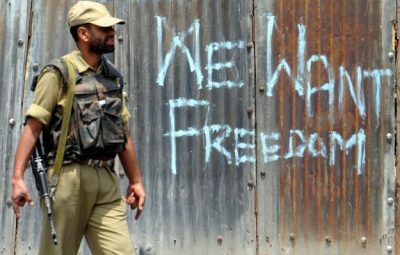Rouf Bhat/AFP
By
Ananya S Guha
We are a nation of symbols. Symbolism works in every aspect of our nation. But the symbolism is outside, within there are contradictions.
What do I mean, you may ask? Well, on the face of it there are secessionist proclivities separatism in many parts of the country. But you probe within there is talk most of the time impassioned of being Indian, fighting for the cause of a nation, national identification and being Indian. That is fine. But the outward and the inward manifestations contradict. They contradict in such a manner that the problem becomes overtly political and stereotype social. Take the example of Azadi in Kashmir. It means, as everyone knows freedom. But does that mean independence? Does that mean merger with another nation? Those who uphold such convictions must also understand that a particular state has perhaps felt manacled over the years. And the political situation of it since independence countenances a social and political turmoil. So, perhaps it is freedom from that unrest, freedom from always seeing men in uniforms, freedom from having been told that its people are lackeys of another country, an out an out enemy of ours?
Azadi in the country in itself has now become a symbol. Not only in Kashmir. But it is the kind of freedom the people need from poverty, shackles of bonded labour, deprivation of the most needed things, education, heath, in fact survival. Azadi from the onslaught of floods, bad crops, suicide of farmers, within which community there there two types, the moneyed farmer, and the crop farmer eking out sustenance and day to day survival. They want freedom, the latter and when they do not have it they commit suicide.
Azadi has shades of connotations in a country with disparities in the social and economic fronts. It is a symbol of desires, freedom from the shackles of bondage and destitution. So if there is a cry for azadi in one part of the country there may be in another, manifestations may be different. What about Nandigram and Singur some years back? Was that not symbolic of a class of people who wanted to be free and live free in mother earth? Or the tussle for land in Assam?
The nation works through a pattern of symbols, a symbolism representing trauma, freedom of expression and dissent. Students too want it. They feel that they have a right to self determination, not to carve out an independent nation, but to read and act upon the charisma of others, of whom they have read or want to read.
In school we read about a mystique surrounding the country and its ethos, ”Unity In Diversity”. Now with religious fundamentalism and still undercurrents of ethnocentric feelings this ultimate symbol of the country’s constitutional aspirations is turning towards a myth.



No Comments Yet!
You can be first to comment this post!